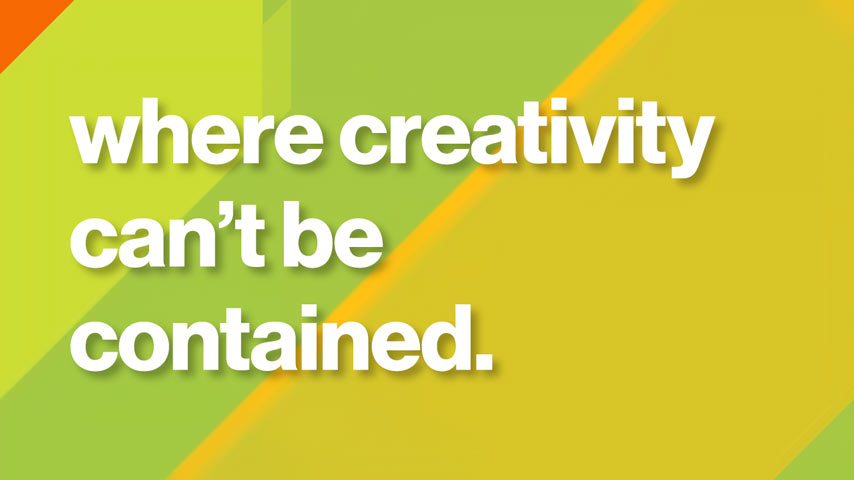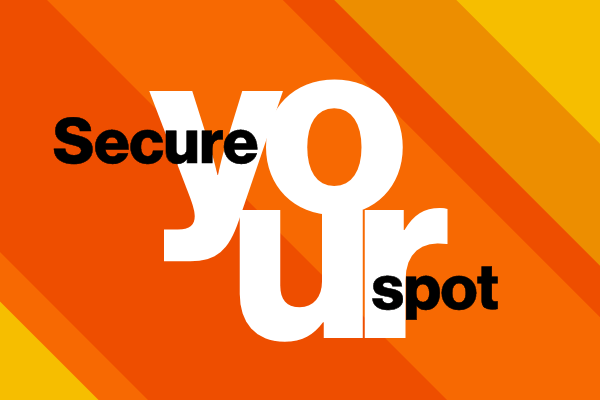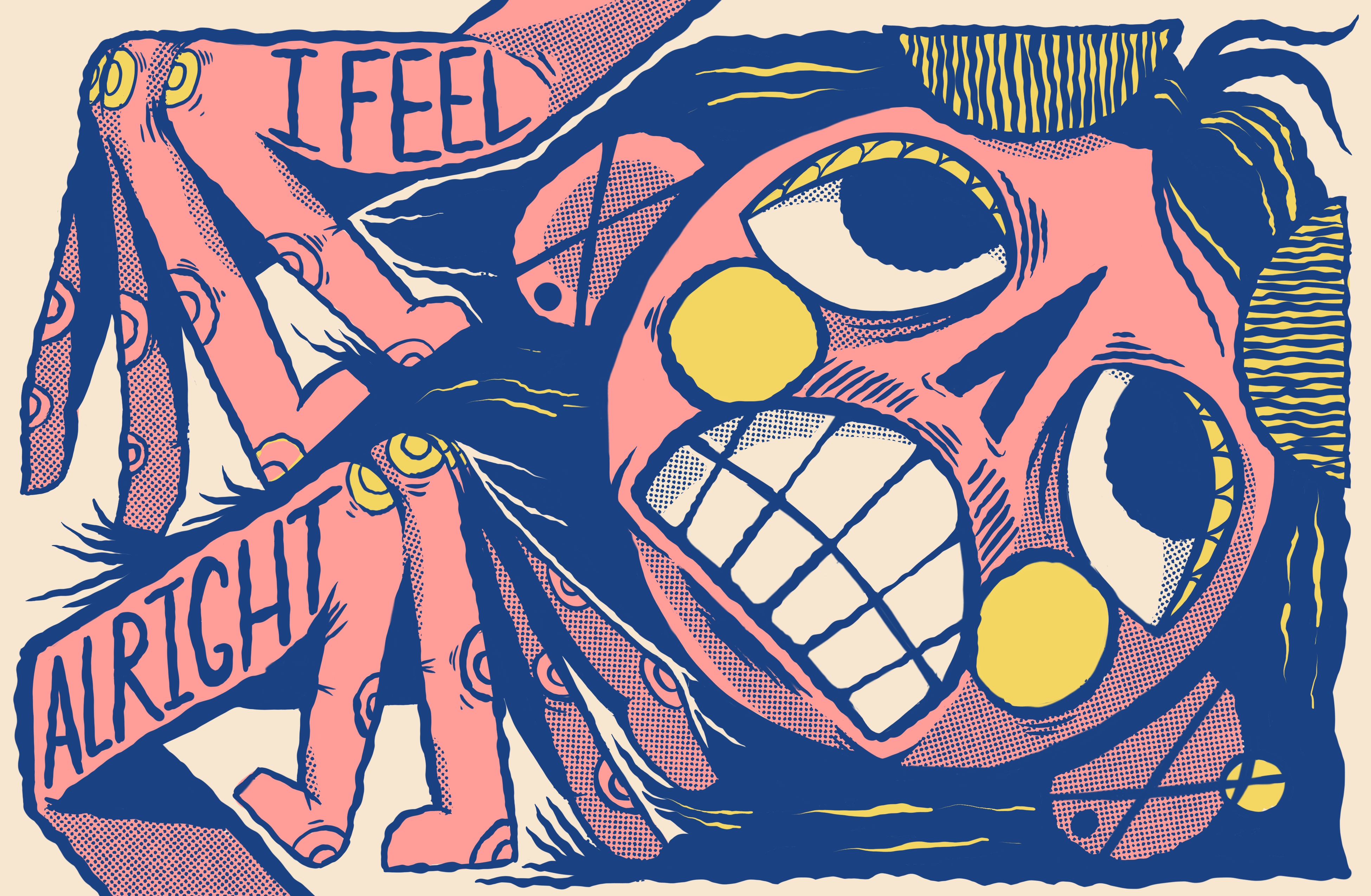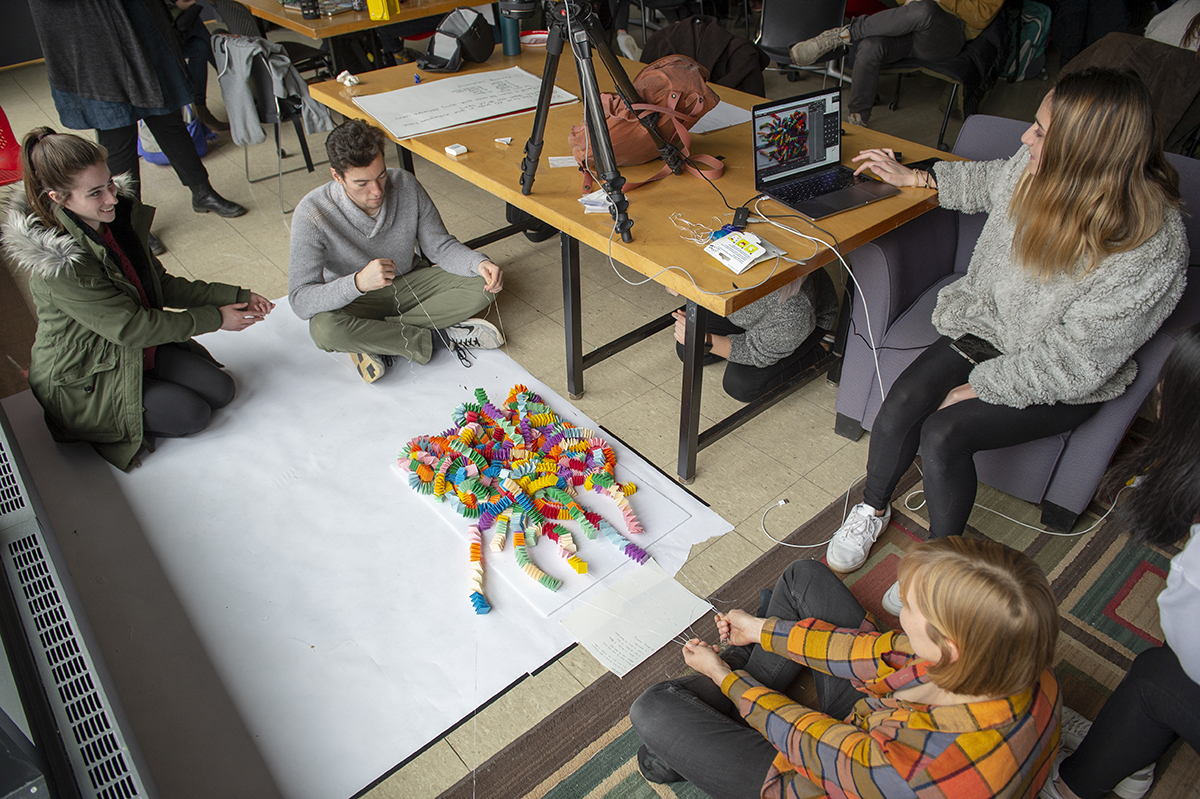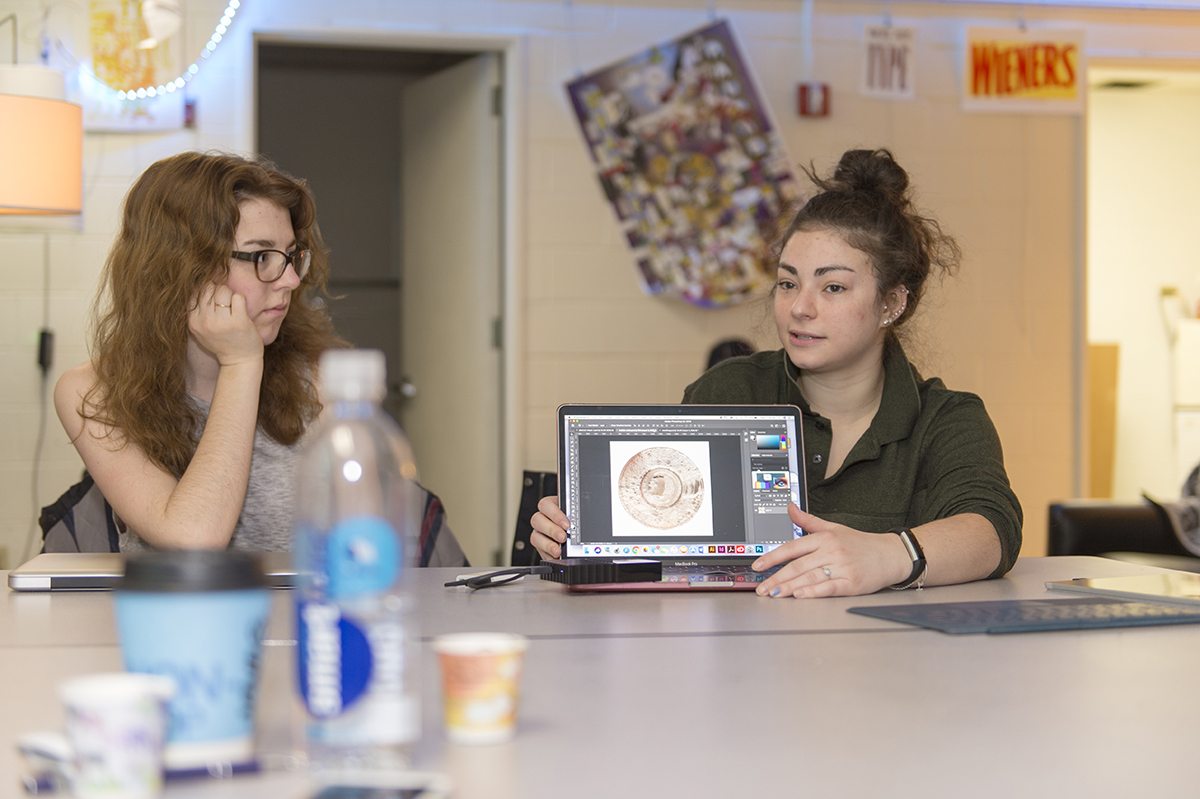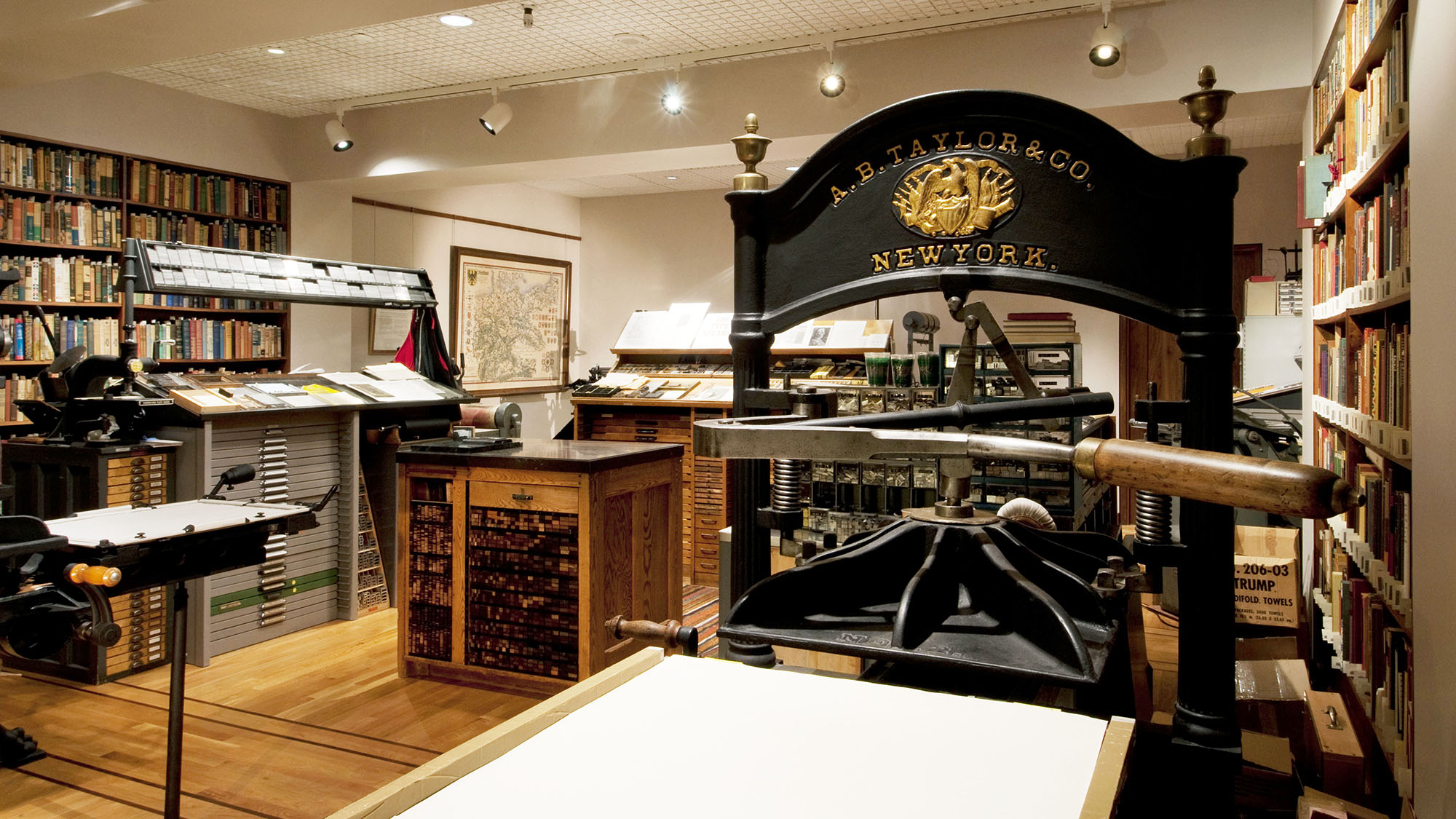Graphic Design Bachelor of Fine Arts Degree

Graphic Design
Bachelor of Fine Arts Degree
- RIT /
- College of Art and Design /
- Academics /
- Graphic Design BFA
In this creative, innovative graphic design BFA, you'll integrate design principles, methods, concepts, images, words, and ideas to convey distinct, visually compelling messages to a range of audiences.
Overview for Graphic Design BFA
Why Study Graphic Design at RIT
Workshops: Multiple annual workshops focused on community engagement and collaboration — including EUREKA!, which allows students to use their skills to initiate social change, and PUSH, a multi-day event captained by an industry designer.
Interesting Topics: Typography, branding and identity systems, designing for space and environment, interactivity and UX/UI, motion graphics, packaging design, publication design, design thinking, history and research.
Strong Career Paths: Students and alumni are employed by top design firms, advertising agencies, and corporations such as Adobe, Apple, ESPN, Fisher-Price, the NHL, Sesame Street, Sports Illustrated, Vogue Italia, and Walt Disney Company.
Industry Exposure: Faculty regularly facilitate collaborative class projects with industry, exposing students to a range of networking opportunities and practical experiences. Course partners have included Kraft, Milwaukee Tool, Mondelez, Precision Botanicals, Roomba, Starbucks, Unilever, and Wegmans.
Graphic design is used in everything from branding and identity, books and magazines, advertising, packaging, web and interface design, motion graphics, and just about everything in between. A graphic design undergraduate degree is perfect for students who eat, breathe, and sleep design, and would like to apply their skills in a hands-on way.
Explore RIT’s Graphic Design BFA Curriculum
In the graphic design undergraduate degree, you can create innovative and effective design solutions through a balanced approach that includes:
- Design thinking
- History
- Theory
- Conceptual explorations
- Problem-solving approaches and strategies
- Applied projects
- Technical development
As an RIT graphic design student, you are exposed to a full range of design topics, including:
- Information design
- Editorial design
- Environmental design
- Wayfinding
- Motion
- Branding
- Signage
- Packaging
- Interactivity
- UX/UI
Our program excels in digital creation but also maintains a large foothold and mastery of typographic principles and print. Being adept at both digital and print design is highly marketable, preparing you for a large range of jobs in the graphic media industry that represent digital, print, or both, while also having the capacity to see comprehensive design solutions and consistency across multiple media.
Hands-On Experience to Gain Real World Skills
We offer collaborative experiences in and out of class that will fully prepare you for internships and co-ops during your studies, and for full-time permanent positions after you graduate. These interdisciplinary and collaborative projects result in innovative and meaningful hands-on projects that encourage you to explore the social, ethical, and environmental impact of design.
You will be well-prepared to pursue positions within design firms, advertising agencies, corporations, and technology companies around the world. Alumni have worked for companies such as American Girl, Dick’s Sporting Goods, Disney, ESPN, Google, L.L. Bean, Mattel, Nickelodeon, Nike, Procter & Gamble, and Sports Illustrated, just to name a few.
Access to World Renowned Facilities
Among many, you will have access to RIT's Vignelli Center for Design Studies, the Cary Graphic Design Archive, and the Cary Graphic Arts Collection, further enhancing your graphic design learning and inquiry.
Furthering Your Education in Graphic Design
Combined Accelerated Bachelor's/Master's Degrees
Today’s careers require advanced degrees grounded in real-world experience. RIT’s Combined Accelerated Bachelor’s/Master’s Degrees enable you to earn both a bachelor’s and a master’s degree in as little as five years of study, all while gaining the valuable hands-on experience that comes from co-ops, internships, research, study abroad, and more.
+1 MBA: Students who enroll in a qualifying undergraduate degree have the opportunity to add an MBA to their bachelor’s degree after their first year of study, depending on their program. Learn how the +1 MBA can accelerate your learning and position you for success.
-
Next Steps to Enroll
Accept your offer of admission and take the next steps toward becoming an RIT Tiger.
Careers and Experiential Learning
Typical Job Titles
| Art Director | Associate Art Director | Creative Designer |
| Creative Director | Digital Designer | Digital Product Designer |
| Freelance Graphic Designer | Graphic Designer | Experience Officer |
| Identity/Packaging Designer | Illustrator | Interactive Designer |
| Junior Art Director | Junior Director | Junior Graphic Designer |
| Motion Designer | Presentation Designer | Product Designer |
| Promotions Marketing Coordinator | Social Media Director | UI/UX Designer |
| Visual Designer | Web Designer | Web Developer |
Industries
-
Advertising, PR, and Marketing
-
Design
-
Higher Education
-
Internet and Software
-
Journalism, Media, and Publishing
-
Movies, TV, and Music
-
Sports and Leisure
Cooperative Education and Internships
What’s different about an RIT education? It’s the career experience you gain by completing cooperative education and internships with top companies in every single industry. You’ll earn more than a degree. You’ll gain real-world career experience that sets you apart. It’s exposure–early and often–to a variety of professional work environments, career paths, and industries.
Co-ops and internships take your knowledge and turn it into know-how. Your art and design co-ops will provide hands-on experience that enables you to apply your artistic capabilities in dynamic professional settings while you make valuable connections between classwork and real-world applications.
Cooperative education, internships, and other experiential learning opportunities are strongly encouraged for students in the BFA in graphic design.
Creative Industry Days
Connect with Design Industry Leaders
RIT’s Office of Career Services and Cooperative Education hosts Creative Industry Days, which connects students majoring in art, design, film and animation, photography, and select computing majors with companies, organizations, creative agencies, design firms, and more. Creative Industry Days are a series of events that allow you to network with company representatives and interview directly for open co-op and full-time employment positions.
Featured Work and Profiles
-
Medical Device Designs
RIT students in the Industrial Design (BFA and MFA) and Graphic Design programs showcased the power of industry partnership as they worked with medical technology company Stryker to design home...
Read More about Medical Device Designs -
-
Students Score with RIT Sports Network
Lexie Mancuso and Amanda Macey Since 2002, more than 1,200 students have gained valuable experience creating a multimedia production ensemble with RIT Sports Network.
Read More about Students Score with RIT Sports Network -
Interactive Design Project with Local Youth
From toymakers to pizza chefs, RIT graphic design students collaborated with local kindergartners to bring a collection of talented, friendly monsters to life.
Read More about Interactive Design Project with Local Youth -
School of Design Reel
Samples of work from each BFA program in RIT's School of Design — 3D digital design, graphic design, industrial design, interior design and new media design.
Read More about School of Design Reel -
Creative Superhero
Since starting her own creative studio in 2009, Erin Sarofsky ’98, ’00 MFA has made prolific title sequences for Marvel films and shows, and directed short films and commercials for the biggest...
Read More about Creative Superhero
Curriculum for 2024-2025 for Graphic Design BFA
Current Students: See Curriculum Requirements
Graphic Design, BFA degree, typical course sequence
| Course | Sem. Cr. Hrs. | |
|---|---|---|
| First Year | ||
| ARTH-1## | Any 100-level ARTH course (General Education-Artistic Perspective) |
3 |
| ARTH-1## | Any 100-level ARTH course (General Education-Global Perspective) |
3 |
| FDTN-111 | Drawing I |
3 |
This course is an introduction to the visualization of form, thought, and expression through the drawing process and is the first of two sequential courses that are the foundation of the drawing curriculum in the College of Art and Design. Concepts are introduced by lectures, discussions, and demonstrations which are designed to provide a broad introductory experience. Students will experiment with a wide variety of media, tools, techniques and subjects to develop drawing and problem-solving skills related to form and composition. The focus of the course is to provide awareness of the full range of ways in which drawing is used as a tool for both self-expression and communication. **Fee: A materials fee is required for this course, and an additional course fee applied via student account** Studio 6 (Fall or Spring). | ||
| FDTN-121 | 2D Design I |
3 |
This course is an introduction to the basic elements and principles of two-dimensional design and is foundational to the College of Art and Design curriculum. The focus of this course is the development of visual and verbal vocabularies as a means of exploring and understanding two-dimensional design. Students will engage with a wide variety of media, tools, and techniques to develop skills while delving into the theoretical and experimentational processes of contemporary art and design. The exploration of historical and cultural themes and concepts intertwined with aspects of personal interpretation and experience will be included in the curriculum. **Fee: A materials fee is required for this course, and an additional course fee applied via student account** Studio 6 (Fall or Spring). | ||
| FDTN-131 | 3D Design I |
3 |
This course presents a progressive study in terminology, visual principles, exploration, concept generation, process, and techniques of three-dimensional design and is foundational to the College of Art and Design curriculum. Using hands-on problem solving, student will develop an informed understanding of the three-dimensional form and space with an emphasis on the elements and principles of visual design and their function as the building blocks and guidelines for ordering a three-dimensional composition. A heightened awareness of form and space will be developed through lecture, assigned projects, and critiques. Students will also develop a personal awareness of problem seeking and solving, experimentation and critical analysis. **Fee: A materials fee is required for this course, and an additional course fee applied via student account** Studio 6 (Fall or Spring). | ||
| Choose one of the following: | 3 |
|
| FDTN-112 | Drawing II |
|
From observation of still life, the figure, and interior/exterior spaces, Drawing II continues to build on the foundation of the College of Art and Design drawing curriculum. This course continues the study of traditional drawing mediums and techniques while introducing color and a selection of contemporary practices and tools through examining organic and geometric mark making, form, space and value. Core concepts are introduced by lectures, discussions, and demonstrations; the primary assessment method of course work will be through critiques which facilitate growth of both a visual and verbal vocabulary. The focus of the course is to provide awareness of the full range of ways in which drawing is used as a tool for self-expression, communication and continued development of creative practice and problem solving. **Fee: A materials fee is required for this course, and an additional course fee applied via student account** (Prerequisites: FDTN-111 or ITDI-211 or equivalent course.) Studio 6 (Fall or Spring). | ||
| FDTN-212 | Drawing II Workshop: Topics |
|
This course is an investigation of the visualization of form, thought and expression through the drawing process. This workshop provides students with the opportunity to learn more about a particular experience in drawing while still covering required foundation elements. Different topics may be taken in the same semester. Topics may only be taken once. Concepts are introduced by lectures, discussions, demonstrations, research and assigned projects.. The focus of the course is to provide awareness of the full range of ways in which drawing is used as a tool for both self-expression and communication. (Prerequisites: FDTN-111 or ITDI-211 or equivalent course.) Studio 6 (Spring). | ||
| GRDE-106 | Graphic Design Studio I |
3 |
This course is an introduction to basic visual communications in the field of graphic design. Lectures will cover graphic design topics ranging from: design thinking methodologies and processes, visual organization and hierarchy principles, color theory and application, and basic typography, to professionalism and ethics. Students will design solutions to visual communication problems through formal studies, perceptual understanding of aesthetics, graphic form and structure, concept development and visual organization. Assignments will explore aspects of graphic imagery, hierarchy, typography, and layout. Students will work with traditional materials and methods as well as develop their computer skills through applications requiring digital formats using industry standard software and hardware. (This course is restricted to GRDE-BFA or PHIMAG-BFA PHVMEDIA Major students.) Lab 3, Studio 2 (Fall or Spring). | ||
| GRDE-107 | Motion Design I |
3 |
This course will introduce the concepts, principles and techniques of motion design and animation. Topics covered are planning and organization methods in the form of storyboards, animatics, kinetics, animation principles, sequencing, composition, visual variables, and forms of narrative storytelling. Focus is on the integration of time and media, such as illustration, photography, video, audio, animation and type, to communicate a moving message. This course will emphasize design from a problem-solving point of view and explores the production-timeline. (This course is restricted to GRDE-BFA or PHIMAG-BFA PHVMEDIA Major students.) Lab 5 (Spring). | ||
| YOPS-10 | RIT 365: RIT Connections |
0 |
RIT 365 students participate in experiential learning opportunities designed to launch them into their career at RIT, support them in making multiple and varied connections across the university, and immerse them in processes of competency development. Students will plan for and reflect on their first-year experiences, receive feedback, and develop a personal plan for future action in order to develop foundational self-awareness and recognize broad-based professional competencies. (This class is restricted to incoming 1st year or global campus students.) Lecture 1 (Fall, Spring). | ||
General Education – First-Year Writing (WI) |
3 | |
| Choose one of the following: | 3 |
|
General Education – Natural Science Inquiry Perspective |
||
General Education – Scientific Principles Perspective |
||
General Education – Mathematical Perspective A |
||
| Second Year | ||
| GRDE-201 | Typography I |
3 |
This course is an introduction to the fundamental principles of typography (the visual representation of language) to effectively convey information and ideas to specific audiences. Focus is on the communicative function and aesthetic nature of typographic problem-solving. Course content and lectures will cover typographic terminology, type anatomy, history of typography as well as type classification, type measurement, and issues of legibility and readability. Once students are introduced to the fundamentals of typography, they will include imagery as appropriate. Students will also refine their skills using relevant software. (Pre-requisites: GRDE-106 and (GRDE-107 or FDTN-141) or equivalent courses.) Lab 3, Studio 2 (Fall or Spring). | ||
| GRDE-202 | Graphic Design Studio II |
3 |
This course will focus on the analysis, creation and use of imagery for communication purposes, along with an introduction to symbol and icon design as it relates to branding. Processes and techniques for creating images are explored. Projects incorporate symbolism, concept development and integration of image and text. This course will build upon the principles and theories learned in Graphic Design Studio I with project solutions developed for print media, motion and digital use. (Pre-requisites: GRDE-106 and (GRDE-107 or FDTN-141) or equivalent courses.) Lab 3, Studio 2 (Fall or Spring). | ||
| GRDE-205 | History of Graphic Design |
3 |
This course will focus on the development of graphic communication from prehistory through the present. This course will provide students with knowledge and understanding of the places, people, events; historical and cultural factors; and technological innovations that have influenced the practice of graphic design. Lectures are complemented by guest speakers, archive visits, videos, research projects, critical writing and discussion. (Prerequisites: Completion of any two ARTH 100 level courses or equivalent courses.) Lecture 3 (Fall or Spring). | ||
| GRDE-206 | Typography II |
3 |
Students will expand upon the principles of grid theory, text and display typography, sequence, page layout, and type and image integration as they relate to a range of design applications: posters, instructional materials, brochures, magazines, books, etc. Visual organization, message communication, and imaging and page layout software skills are integrated in the course. (Prerequisite: GRDE-201 or GRDE-202 or equivalent course.) Lab 3, Studio 2 (Fall or Spring). | ||
| GRDE-207 | Interactive Design I |
3 |
This course provides an introduction to interactivity through the study of basic principles and methodologies involved in designing digital interfaces. Students will engage in projects where they will investigate, conceptualize and propose innovative interactive solutions to problems through a human-centered design approach. Students will create navigable interfaces and systems that allow audiences to achieve meaningful goals through compelling content, connecting people to people and people to information and environments. The course will also provide an introduction to building websites and developing interactive components using industry standard coding languages and software. (Prerequisite: GRDE-201 or GRDE-202 or equivalent course.) Lab 5 (Spring). | ||
| GRDE-217 | Motion Design II |
3 |
This comprehensive course will expand student knowledge of motion principles and theories and allow students to hone their technical skills. The course will cover advanced principles of motion graphics and animated storytelling. Focus will be on complex motion and animation techniques and best workflow practices. Two-dimensional and three-dimensional elements will be incorporated in working with spatial and visual continuity. Emphasis will be on experimentation, interactive storytelling, and the ability to convey a message through motion. Advanced techniques such as graph editors, working in 3D space with camera and motion tracking, video, audio, rotoscoping, compositing, and rendering will be introduced. (Pre-requisites: GRDE-106 and (GRDE-107 or FDTN-141) or equivalent courses.) Lab 5 (Spring). | ||
CAD Studio Elective† |
3 | |
Open Elective |
3 | |
General Education – Ethical Perspective |
3 | |
General Education – Social Perspective |
3 | |
| Third Year | ||
| GRDE-301 | Graphic Design Studio III |
3 |
This course will explore information design. Problem-solving focuses on functional requirements, information transmission, accessibility, and design structure across a range of formats. Applied problems are solved through principles of systems thinking, structure, diagrammatic interpretation, and the visual display of information. This course will build upon the principles and theories learned in Graphic Design Studio II with project solutions developed for print media, motion and digital use. (Prerequisites: GRDE-206 and GRDE-207 and GRDE-217 or equivalent courses.) Lab 3, Studio 2 (Fall). | ||
| GRDE-302 | Interactive Design II |
3 |
This course encompasses and expands on previous interactive design, development, and graphic design experience. In this class, the application of user-centered design methodologies will be emphasized in the planning and implementing of interactive, instructional projects across multiple devices and platforms. Thorough exploration of the user experience will explored, and the resulting informed decisions on designing effective user interfaces. Students will engage in projects that incorporate contemporary social-cultural issues and will directly handle real content to define the underlying information architecture and structure of their interactive solutions. Design patterns, current, and future trends related to UI design will be discussed and applied according to industry’s best practices. (Pre-requisites: GRDE-206 and GRDE-207 and GRDE-217 or equivalent courses.
Co-requisite: GRDE-301 or equivalent course.) Lab 5 (Fall). | ||
| GRDE-306 | Professional Practices |
3 |
In this course students will learn strategies to obtain internships and permanent employment in the graphic design profession. Emphasis will be placed on the various positions available to designers, the designer/client relationship, business aspects of design, and professional ethics and expectations. At the conclusion of this course students will be able to create promotional materials, including resume and portfolio design so that students can effectively and professionally present themselves in the field. (Prerequisites: GRDE-207 or equivalent course.) Lecture 3 (Fall). | ||
| GRDE-307 | Design Systems I |
3 |
This course will provide students with conceptual, organizational, and aesthetic problem-solving methods to create unified and effective design systems, such as corporate identity systems, icon sets, poster and/or packaging series. Students will have an opportunity to synthesize graphic design principles from their previous courses into more advanced and in-depth projects. Research, concept generation, and relevant aesthetic principles will be emphasized. Presentation, writing, and professional skills will be a focus to prepare students for senior year coursework . Teamwork strategies and skills are implemented throughout the semester. (Prerequisites: GRDE-301 and GRDE-302 or equivalent courses.) Lab 3, Lecture 2 (Spring). | ||
| GRDE-308 | Experiential Graphic Design |
3 |
This course will focus on design problem solving for three-dimensional spaces and environments. Design process, initial concepts, and final design solutions are developed to assist users in negotiating various interior and exterior environments. Areas of application may include: architectural graphics, signage systems, exhibit design, themed museum experiences, and dynamic environments. Two-dimensional, three-dimensional, and digital design attributes are incorporated using appropriate materials and software. (Prerequisites: GRDE-301 and GRDE-302 or equivalent courses.) Lab 3, Studio 2 (Spring). | ||
Art History Elective‡ |
3 | |
CAD Studio Elective† |
3 | |
Open Elective |
3 | |
General Education – Immersion 1 (WI), 2 |
6 | |
| Fourth Year | ||
| GRDE-411 | Graphic Design Capstone I (WI-PR) |
3 |
Students will identify a topic to research with the objective of bringing innovation or new knowledge to this area. Students will acquire and practice the skills necessary to initiate and complete the research phase. Students will identify faculty and industry experts to serve as advisors providing feedback throughout the semester. At the conclusion of this course, students will write an abstract and submit this to the advisors for approval. Emphasis will be on experimentation, exploration, and development of a wide range of ideas. Cross-discipline capstones may be proposed and will be considered on a case-by-case basis. (Prerequisites: GRDE-307 and GRDE-308 and completion of First Year Writing (FYW) requirement or equivalent courses.
Co-requisite: GRDE-421 or equivalent course.) Studio 6 (Fall or Spring). | ||
| GRDE-412 | Graphic Design Capstone II |
3 |
In this course, students’ working knowledge of graphic design will culminate in a comprehensive capstone project. The content of each capstone project will vary depending upon each students' focus/direction and approval from their instructor. The students will build on previous course work. Process and in-progress development is shared via class presentations and a final public exhibition for dissemination. A final formal presentation is required. (Prerequisites: GRDE-411 and GRDE-421 or equivalent courses.) Studio 5 (Spring). | ||
| GRDE-421 | Design Systems II |
3 |
This course will provide an overview of branding and identity design. Processes, theories, design methods, brand strategies, positioning, touch-points, research, and management are introduced in creating comprehensive branding and identity systems. Case studies will provide students with historical context. Students will explore current and future trends related to branding. (Prerequisites: GRDE-306 and GRDE-307 and GRDE-308 or equivalent courses.) Studio 5 (Fall). | ||
Professional Electives |
6 | |
Open Electives |
9 | |
General Education – Immersion |
3 | |
General Education – Elective |
3 | |
| Total Semester Credit Hours | 120 |
|
Please see General Education Curriculum (GE) for more information.
(WI) Refers to a writing intensive course within the major.
Please see Wellness Education Requirement for more information. Students completing bachelor's degrees are required to complete two different Wellness courses.
† CAD Studio Elective courses are any College of Art and Design course with a studio or lab component, per catalog restrictions.
‡ Art History electives are non-studio courses searchable in SIS with the Art History attribute of ARTH; and are 200 level or above.
Electives
Graphic Design Electives
| Course | ||
|---|---|---|
| GRDE-401 | Collaborative Design |
|
This course offers students the opportunity and challenge of working on interdisciplinary and multidisciplinary teams to create professional level projects, which are collaborative, competitive and cooperative in structure and implementation. The content of the course will vary depending upon faculty expertise and coordination between departments, schools and colleges, as well as possible outside non-profit clients. (Prerequisites: GRDE-306 and GRDE-307 and GRDE-308 or equivalent courses.) Lecture 2, Studio 3 (Fall, Spring). | ||
| GRDE-418 | Editorial Design |
|
This course will explore the role of a graphic designer in developing effective and innovative communication for editorial design. Students will work on interdisciplinary teams (with photographers and/or illustrators) to create visual solutions for in-class projects and/or a magazine produced by the class. Design development processes and aspects of production methods will be implemented, and innovative techniques in digital publication design will be explored. (Prerequisites: GRDE-307 and GRDE-308 or equivalent courses.) Studio 5 (Fall or Spring). | ||
| GRDE-422 | Interactive Design III |
|
This course focuses on the application of advanced interactive methods using graphic design concepts, principles, and processes, along with the theories and methodologies of interactive design. Students will develop and refine skills in project planning, research, interface design and methods, UX/UI and usability through applied projects. Students will be encouraged to explore highly structured as well as highly experimental approaches to merging content with interactivity design while also incorporating social-cultural issues. (Prerequisites: GRDE-302 and GRDE-307 or equivalent courses.) Lab 5 (Fall or Spring). | ||
| GRDE-423 | Typography III |
|
This course will provide students an advanced study of typography as it relates to graphic design, including historical and contemporary contexts. Terminology and advanced applications of typography, complex grid systems, experimental typographic methods, and material studies will be explored. The development of a personal creative approach to form and communication will be emphasized. (Prerequisites: GRDE-302 and GRDE-307 or equivalent courses.) Studio 5 (Fall or Spring). | ||
| GRDE-428 | Advertising Design |
|
This course will explore the role of the graphic designer in developing communicative design for advertising. Emphasis will be placed on effective communication of the concept development and client’s message. Advertising will be addressed in a broad context, and the course will include the relationship and use of typography, photographic imagery and layout for advertising impact. At times, this course will collaborate with an upper-level advertising photography class to better understand and experience the working relationship between the photographer and the designer. Some projects will be with outside clients, such as non-profit organizations or the Ad Council. (Prerequisites: GRDE-307 and GRDE-308 or equivalent courses.) Studio 5 (Fall or Spring). | ||
| GRDE-431 | Packaging Systems Collaborative |
|
This course focuses on the design of physical packaging for the protection and marketing of goods. Aspects of visual, structural, ergonomic and environmental issues are considered in the design of rigid and flexible containers. Taught as a team/collaborative course, students from graphic design, packaging science, and industrial design will work together to develop effective packaging design solutions. (Prerequisites: GRDE-307 and GRDE-308 or equivalent courses.) Studio 5 (Fall or Spring). | ||
| GRDE-432 | Packaging Systems Projects |
|
This course will focus on the design of physical packaging for the protection and marketing of goods. Aspects of visual, structural, ergonomic and environmental issues are considered in the design of rigid and flexible containers, in order to develop effective packaging design solutions. (Prerequisites: (GRDE-307 and GRDE-308) or IDDE-301 or equivalent courses..) Studio 5 (Fall or Spring). | ||
Admissions and Financial Aid
First-Year Admission
First-year applicants are expected to demonstrate a strong academic background that includes:
- 4 years of English
- 3 years of social studies and/or history
- 3-4 years of mathematics
- 2-3 years of science
- Studio art experience and a portfolio of original artwork are required. View Portfolio Requirements for more information.
Transfer Admission
Transfer applicants should meet these minimum degree-specific requirements:
- Studio art or design experience and a portfolio of original artwork are required. View Portfolio Requirements for more information.
Financial Aid and Scholarships
100% of all incoming first-year and transfer students receive aid.
RIT’s personalized and comprehensive financial aid program includes scholarships, grants, loans, and campus employment programs. When all these are put to work, your actual cost may be much lower than the published estimated cost of attendance.
Learn more about financial aid and scholarships
Related News
-
March 20, 2025

Celebrating Women’s History Month through interdisciplinary research
The inaugural Women, Gender, and Sexuality Studies symposium, hosted on March 28, will feature original work by individuals from across the RIT community.
-
January 14, 2025

New RIT student-designed bookmobile drives library access
RPL GO!, a van retrofitted with library materials and offerings, will visit local neighborhoods in service of individuals unable to access physical library branches.
-
September 12, 2024

RIT student team named finalists in national packaging design challenge
Five students from RIT combined talents and designed a packaging campaign for garlic that will be among the finalists for the Paperboard Packaging Student Design Challenge.
Contact
- Keli DiRisio
- Undergraduate Program Director, Graphic Design
- School of Design
- College of Art and Design
- 585‑475‑5581
- keli.dirisio@rit.edu
School of Design





